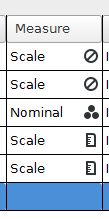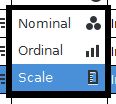
This work is licensed under a Creative Commons Attribution 4.0 International License that allows sharing, adapting, and remixing.
The "measure" setting informs PSPP about the scale or level of measurement. The concept of measurement scales is credited to Stanley S. Stevens, who proposed that the concepts of nominal, ordinal, interval, and ratio scales. The measurement scale setting can be useful when choosing the analyses at a later point in time. PSPP can use this variable information to help determine which tests might be the most appropriate.
Commentary: The description of scale characteristics as a "measure" is a bit informal and was possibly done to save screen space in the software. The "measure" is best understood as a measurement scale or measurement level that would ideally be assigned to each variable to record the measurement characteristics.

PSPP has three possible scale settings.

Nominal scales represent categories. Our Sex variable is a category (male or female), so it was set to nominal.
Ordinal scales are used for numbers that represent rankings that may not have a uniform interval size. An example would be ranking people in a sample based on how tall they are. For example, the tallest person would be #1, the next tallest would be #2, and so on. Stanley Stevens argued that many psychological variables have ordinal scales (e.g., 1 to 5 ratings of approval), but not everyone agrees with this idea.
The Scale setting is for data that have a consistent unit size, such as seconds, grams, and meters. The Scale setting represents both interval scales (equally sized units but no zero point) and ratio scales (equally sized units and a zero point). It is not clear why interval scales and ratio scales are treated the same by the software.
The measurement scales have helpful icons to assist in understanding their functions. Nominal scales look like a Venn diagram with no overlap between the circles. This is meant to represent the categories of a nominal variable. Ordinal looks like bar columns that progressively increase, thereby representing a ranking. Scale looks like a ruler with the equal intervals that a ruler contains. In addition, the LastName and FirstName variables have a no symbol or prohibition sign (see the above screenshot). These are string variables, so numerical scale information is simply not relevant for these variables.
Index | Next - Switch to the Data View

This work is licensed under a Creative Commons Attribution 4.0 International License that allows sharing, adapting, and remixing.